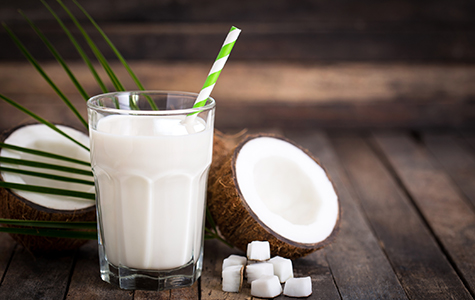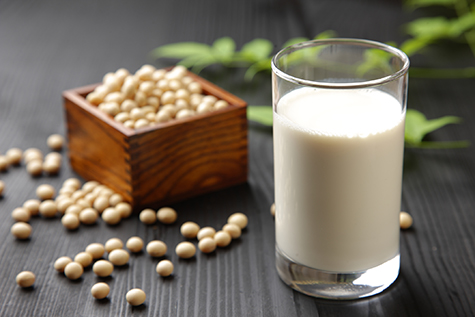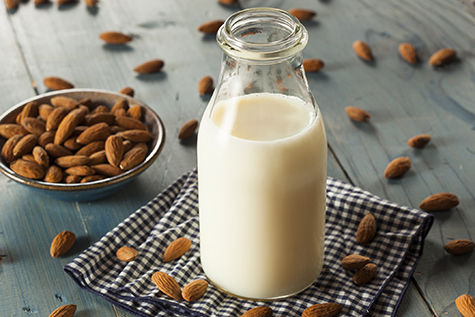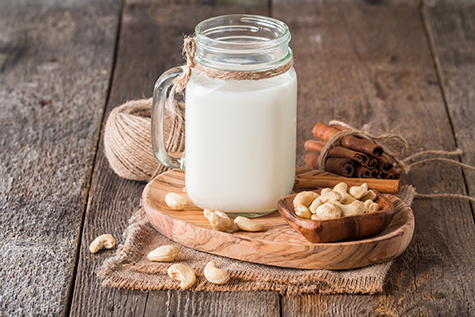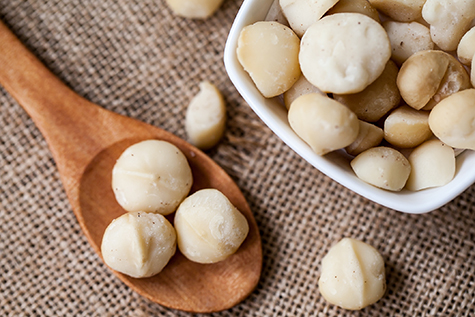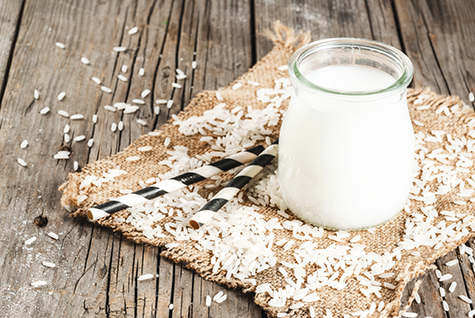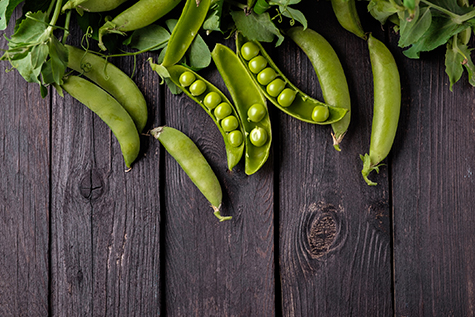We’re Going Nuts for Plant-Based Milks

The dairy aisle used to be so simple—whole milk, low fat milk, non-fat milk, half and half, cream and maybe goat’s milk if it was a health food store. With the growing number of people with lactose intolerance, or those following a vegan diet, the consumption of plant-based ‘milks’ has been expanding by about 11 percent each year since 1999. Consumption of cow’s milk has declined by 25 percent since 1975, according to Cooking Light Magazine.
Cow’s milk was for decades considered an almost perfect food with 8g protein, 460 mg potassium (13% of the RDA), 35% of the RDA for calcium and 25% of the RDA for vitamin D. But many adults don’t want to consume the calories and fat (from whole milk), and are avoiding animal products with the possibility of added growth hormones and antibiotics.
The decision to use nut or other plant-based milks really depends on what you want nutritionally. For high quality protein, vitamins and minerals, cow (or goat) milk is the way to go. Certainly children require the nutrients found in milk from cows. Plant-based milks are excellent lower calorie alternatives to cow milk with the added benefit of being versatile enough for drinking, cereal, coffee and smoothies, but without the lactose.
Another thing to keep in mind—while nut milks are growing in popularity, they have little of the beneficial protein, fiber and vitamins found in the nuts from which they’re made. Many nut milks are fortified with pea protein, calcium phosphate or calcium carbonate to increase the calcium, and vitamins. Nutrients can vary from brand to brand, so read labels carefully!
Here’s a run-down of popular plant-based milks and how to use them:
Soy Milk
With 7-8g of protein, soy milk is the plant-based milk with the highest amount of this essential nutrient. While a good choice for those who are lactose intolerant, some people may have soy allergies. Also, as with all nut milks, watch out for added sugar. Stick with the ones that are designated, ‘unsweetened.’ The ones labeled ‘original’ have added sugar. Soy milk is a good substitute for cow’s milk in baking and in smoothies.
Almond Milk
Almond milk is the biggest seller of the plant-based milks and accounts for about 4 percent of all milk sales in the dairy case. Its taste and texture make it a great alternative for milk. Keep in mind that almond milk is 98% water– a very small handful of almonds goes into the manufacture of a quart of almond milk, so it doesn’t provide all the great nutrition almonds do. Almond milk is frequently fortified with calcium and vitamins A and D. Read the label! The pros of almond milk are that it is very low in calories and has a mildly nutty flavor that complements hot and cold cereals, coffee and blended beverages.
Cashew Milk
Also low in calories—less than 60 calories per 8 oz. serving – but doesn’t provide much nutritional value. However, it has a creamy consistency, a mild, nutty flavor and will lighten coffee deliciously. Also, it’s usually fortified with calcium and vitamins A and D.
Macadamia Nut Milk
Again, this tasty beverage is relatively low in calories with 50 per 8 oz, serving. Available commercially, the product usually has calcium added, so some brands can provide 45% of the RDA requirement. Macadamia nut cream is easy to make. See the recipe below.
Rice Milk
Original rice milk has more calories and carbs (11g) than the other milk alternatives, but at 70 calories per 8 oz. serving, is lower than even skim milk (83 calories). The drawback is that it contains no protein and the production process pretty much refines out most of the nutrition of the brown rice from which it’s made. Rice milk is almost identical to skim cow milk in consistency and has a slightly sweet taste. Good in cereal.
Coconut Milk
Coconut is one of the creamier milk alternatives because it contains saturated fat. It’s usually fortified with calcium and vitamin D, but contains no protein. The flavor can be slightly tart with a bit of a coconut aftertaste.
Pea Milk
Like soy milk, pea milk provides a decent amount of protein, about 8g, which comes close to the protein in cow’s milk. The drawback that the most available brand has is that it contains sunflower oil to enhance creaminess and this oil is primarily omega-6 fatty acids, which is known to contribute to inflammation. The creamy texture and the slight legume after taste make pea milk a good choice for savory, creamy-based soups and sauces.
I rely quite a bit on plant-based milks in my recipes. Using them reduces calories and makes them deliciously vegan.
From the Age Beautifully Cookbook, here’s a delicious cold soup perfect for hot summer days. My Mock Sour Cream makes this cucumber-and-celery creation a vegan treat. This soup can be served as an appetizer, a main course, or even a palate cleanser between courses. Cucumbers are a good source of vitamin K, an anti-inflammatory nutrient that benefits both your heart and your bones.
Chilled Cucumber Soup
Serves 2–4
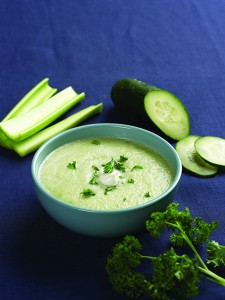 Ingredients
Ingredients
4 cups peeled, seeded, and chopped cucumber
1½ cups almond milk (or pea milk)
1 cup chopped celery, strings removed
¼ cup Mock Sour Cream (or low-fat sour cream), plus extra for garnish
2 Tbs. white balsamic vinegar
2 Tbs. parsley
1 Tbs. olive oil
½ tsp. minced garlic
½ tsp. salt or salt substitute
Procedure
- Combine all the ingredients in a blender and blend on high speed for 2–3 minutes or until smooth.
- Chill in the refrigerator for 2–3 hours.
- Serve in chilled bowls and garnish with sour cream.
FoodTrients
![]() –Beauty – Promotes vibrant skin and hair and helps keep eyes healthy
–Beauty – Promotes vibrant skin and hair and helps keep eyes healthy
![]() –Mind – Improves memory and focus
–Mind – Improves memory and focus
Macadamia Cream
Yields 2 cups
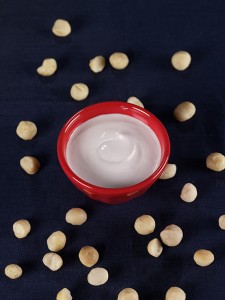 Ingredients
Ingredients
1 cup raw, organic macadamia nuts
1 cup warm water
Procedure
- Soak the nuts in the water for 1 hour.
- Blend in a powerful blender or food processor for 1-2 minutes or until cream is thick, smooth and somewhat fluffy.
Mock Sour Cream
Yields 2 cups
Ingredients
1 Tbs. fresh lemon juice
1 recipe Macadamia Cream, divided in half
Procedure
- Combine the lemon juice and the ½ cup of the Macadamia Cream.
- Mix in the remaining Macadamia Cream.
Macadamia Cream Flan
 Also from the Age Beautifully Cookbook, my dairy-free Macadamia Cream is very decadent tasting and smooth. I use organic, free-range, or Omega-3-enriched eggs for added benefits. You can use almonds or cashews instead of macadamia nuts.
Also from the Age Beautifully Cookbook, my dairy-free Macadamia Cream is very decadent tasting and smooth. I use organic, free-range, or Omega-3-enriched eggs for added benefits. You can use almonds or cashews instead of macadamia nuts.
Macadamia nuts are rich in heart-healthy, anti-inflammatory monounsaturated fats. Eating more of these healthy fats can help keep your skin youthful and your waistline trim. Egg yolks contain lutein, which reduces the risk of cataracts and age-related macular degeneration.
Yields 8 small servings
Ingredients
Caramel
½ cup water
1 cup xylitol or sugar
Flan
8 egg yolks (organic, free-range, or Omega-3-enriched)
1 egg (organic, free-range, or Omega-3-enriched)
2 cups Macadamia Cream
⅔ cup xylitol or sugar
1 tsp. lemon zest
Procedure
- Preheat the oven to 375 degrees.
- Make the caramel: In a small saucepan, combine the water and sugar and cook over medium heat for 8–10 minutes or until the mixtures bubbles and turns golden brown. Do not stir!
- Remove from the heat and pour into two flan molds or 4–6 ramekins. Tilt the molds/ramekins to evenly distribute the caramel along the bottom.
- Make the flan: In a large mixing bowl, whisk the egg yolks and the whole egg for about 5 minutes. Add the Macadamia Cream, sugar, and lemon zest. Whisk for another 5 minutes.
- Strain the flan into the caramel-bottomed flan molds or ramekins.
- Place the molds in a large baking dish and fill the dish ⅓ of the way with hot water. Cover the molds with aluminum foil and bake at 375 degrees for 1 hour.
- Remove the foil and bake another 10–15 minutes or until the flan sets.
- Remove the molds from the baking dish. Allow to cool for 20 minutes, then chill in the refrigerator for at least 2 hours.
- Run a knife around the inside edge of one mold/ramekin. Invert the flan onto a small plate and serve immediately. Repeat with the remaining molds/ramekins.
Chef’s Note
To turn this flan into a crème brûlée, omit the caramel and begin with step 3. Bake the flan in the ramekins, not in the flan pans. Cool the flan as usual. After cooling (step 10), remove the flan from the refrigerator and sprinkle the top of each ramekin with 2 Tbs. of granulated sugar. Using a kitchen torch, burn the sugar until it is brown and glassy. Allow the crème brûlée to cool slightly and serve.
FoodTrients
![]() –Beauty – Promotes vibrant skin and hair and helps keep eyes healthy
–Beauty – Promotes vibrant skin and hair and helps keep eyes healthy
